tow TOYOTA BZ4X 2022 (in English) User Guide
[x] Cancel search | Manufacturer: TOYOTA, Model Year: 2022, Model line: BZ4X, Model: TOYOTA BZ4X 2022Pages: 674, PDF Size: 120.02 MB
Page 130 of 674
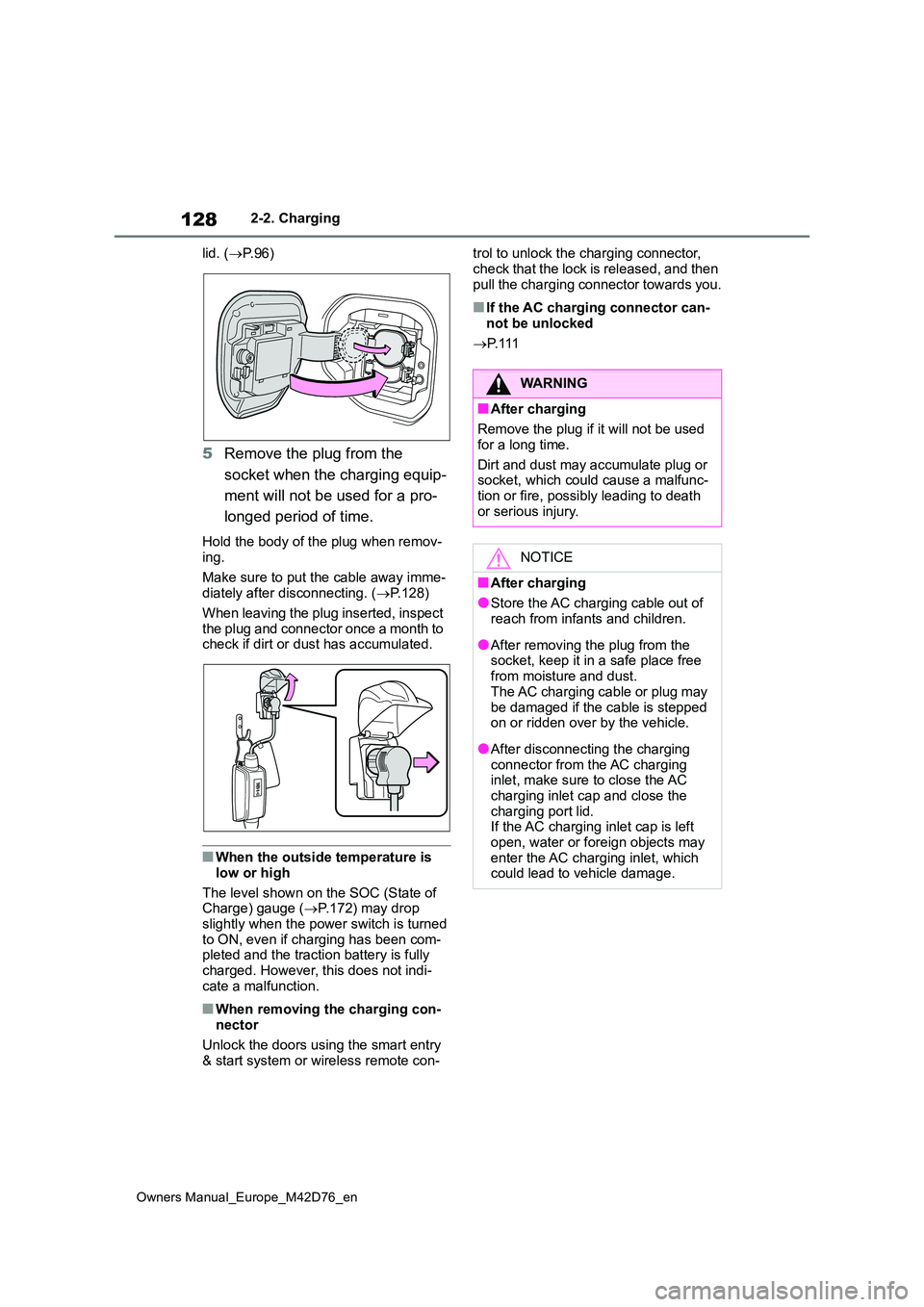
128
Owners Manual_Europe_M42D76_en
2-2. Charging
lid. ( P. 9 6 )
5Remove the plug from the
socket when the charging equip-
ment will not be used for a pro-
longed period of time.
Hold the body of the plug when remov- ing.
Make sure to put the cable away imme- diately after disconnecting. ( P.128)
When leaving the plug inserted, inspect
the plug and connector once a month to check if dirt or dust has accumulated.
■When the outside temperature is
low or high
The level shown on the SOC (State of Charge) gauge ( P.172) may drop
slightly when the power switch is turned to ON, even if charging has been com-pleted and the traction battery is fully
charged. However, this does not indi- cate a malfunction.
■When removing the charging con-nector
Unlock the doors using the smart entry & start system or wireless remote con-
trol to unlock the charging connector,
check that the lock is released, and then pull the charging connector towards you.
■If the AC charging connector can-not be unlocked
P. 1 1 1
WARNING
■After charging
Remove the plug if it will not be used
for a long time.
Dirt and dust may accumulate plug or socket, which could cause a malfunc-
tion or fire, possibly leading to death or serious injury.
NOTICE
■After charging
●Store the AC charging cable out of reach from infants and children.
●After removing the plug from the socket, keep it in a safe place free
from moisture and dust. The AC charging cable or plug may
be damaged if the cable is stepped on or ridden over by the vehicle.
●After disconnecting the charging connector from the AC charging inlet, make sure to close the AC
charging inlet cap and close the charging port lid.If the AC charging inlet cap is left
open, water or foreign objects may enter the AC charging inlet, which could lead to vehicle damage.
Page 199 of 674
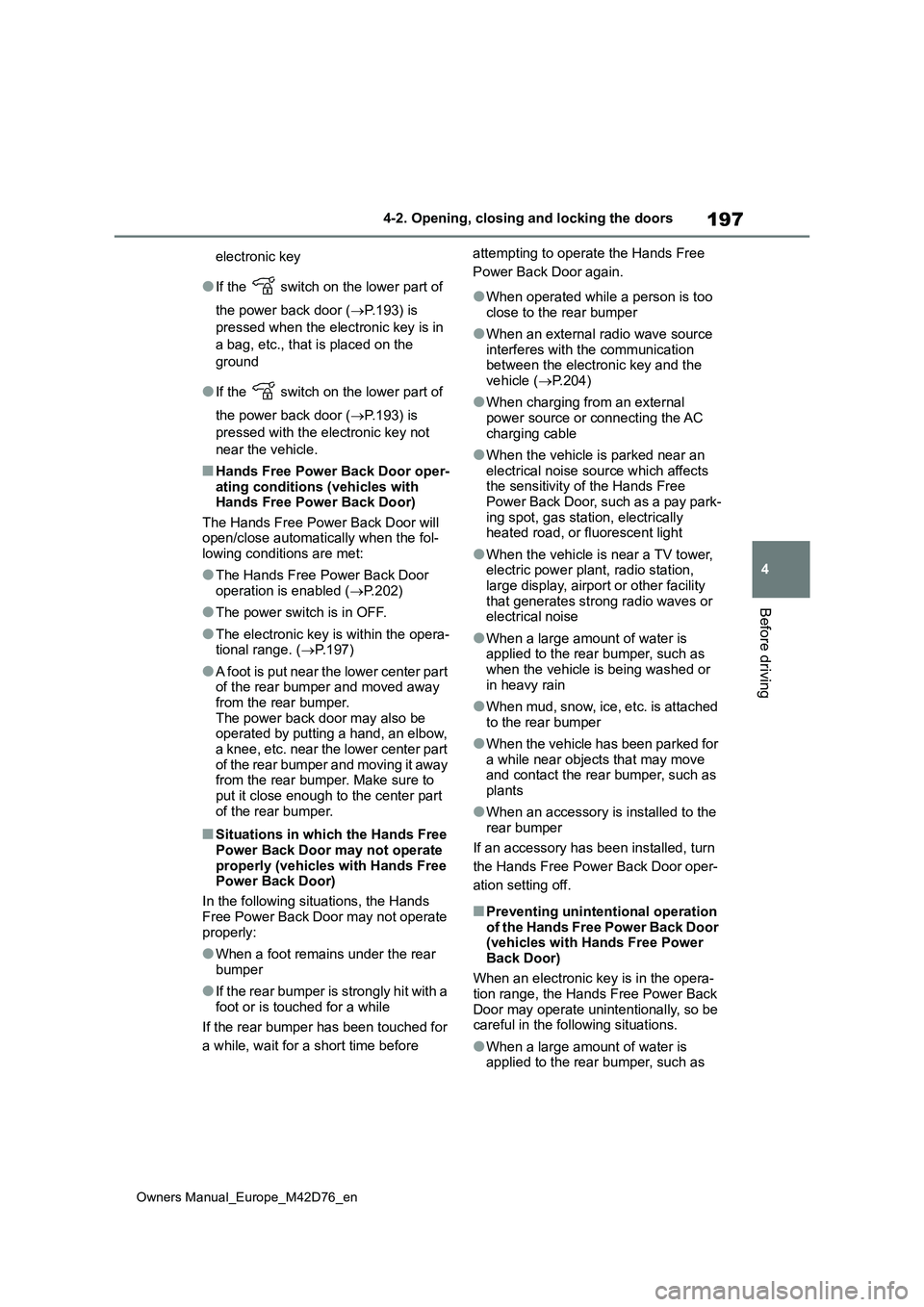
197
4
Owners Manual_Europe_M42D76_en
4-2. Opening, closing and locking the doors
Before driving
electronic key
●If the switch on the lower part of
the power back door ( P.193) is
pressed when the electronic key is in
a bag, etc., that is placed on the
ground
●If the switch on the lower part of
the power back door ( P.193) is
pressed with the electronic key not
near the vehicle.
■Hands Free Power Back Door oper- ating conditions (vehicles with Hands Free Power Back Door)
The Hands Free Power Back Door will open/close automatically when the fol-lowing conditions are met:
●The Hands Free Power Back Door operation is enabled ( P.202)
●The power switch is in OFF.
●The electronic key is within the opera- tional range. ( P.197)
●A foot is put near the lower center part of the rear bumper and moved away from the rear bumper.
The power back door may also be operated by putting a hand, an elbow,
a knee, etc. near the lower center part of the rear bumper and moving it away from the rear bumper. Make sure to
put it close enough to the center part of the rear bumper.
■Situations in which the Hands Free Power Back Door may not operate
properly (vehicles with Hands Free Power Back Door)
In the following situations, the Hands
Free Power Back Door may not operate properly:
●When a foot remains under the rear bumper
●If the rear bumper is strongly hit with a foot or is touched for a while
If the rear bumper has been touched for
a while, wait for a short time before
attempting to operate the Hands Free
Power Back Door again.
●When operated while a person is too close to the rear bumper
●When an external radio wave source interferes with the communication between the electronic key and the
vehicle ( P.204)
●When charging from an external
power source or connecting the AC charging cable
●When the vehicle is parked near an electrical noise source which affects the sensitivity of the Hands Free
Power Back Door, such as a pay park- ing spot, gas station, electrically heated road, or fluorescent light
●When the vehicle is near a TV tower, electric power plant, radio station,
large display, airport or other facility that generates strong radio waves or electrical noise
●When a large amount of water is applied to the rear bumper, such as
when the vehicle is being washed or in heavy rain
●When mud, snow, ice, etc. is attached to the rear bumper
●When the vehicle has been parked for a while near objects that may move and contact the rear bumper, such as
plants
●When an accessory is installed to the
rear bumper
If an accessory has been installed, turn
the Hands Free Power Back Door oper-
ation setting off.
■Preventing unintentional operation of the Hands Free Power Back Door (vehicles with Hands Free Power
Back Door)
When an electronic key is in the opera- tion range, the Hands Free Power Back
Door may operate unintentionally, so be careful in the following situations.
●When a large amount of water is applied to the rear bumper, such as
Page 200 of 674
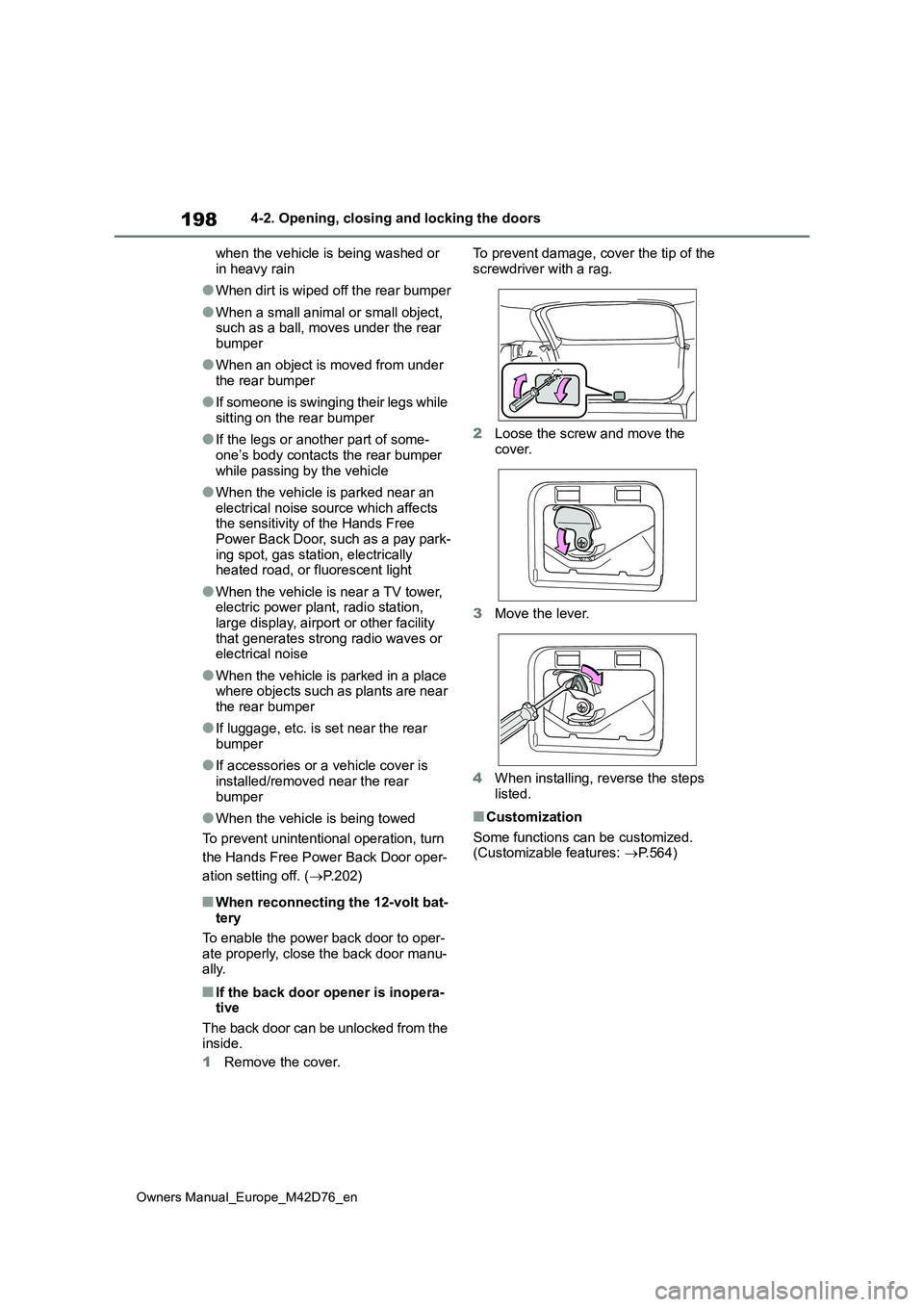
198
Owners Manual_Europe_M42D76_en
4-2. Opening, closing and locking the doors
when the vehicle is being washed or
in heavy rain
●When dirt is wiped off the rear bumper
●When a small animal or small object, such as a ball, moves under the rear
bumper
●When an object is moved from under
the rear bumper
●If someone is swinging their legs while
sitting on the rear bumper
●If the legs or another part of some-
one’s body contacts the rear bumper while passing by the vehicle
●When the vehicle is parked near an electrical noise source which affects the sensitivity of the Hands Free
Power Back Door, such as a pay park- ing spot, gas station, electrically heated road, or fluorescent light
●When the vehicle is near a TV tower, electric power plant, radio station,
large display, airport or other facility that generates strong radio waves or electrical noise
●When the vehicle is parked in a place where objects such as plants are near
the rear bumper
●If luggage, etc. is set near the rear
bumper
●If accessories or a vehicle cover is
installed/removed near the rear bumper
●When the vehicle is being towed
To prevent unintentional operation, turn
the Hands Free Power Back Door oper-
ation setting off. ( P.202)
■When reconnecting the 12-volt bat- tery
To enable the power back door to oper-
ate properly, close the back door manu- ally.
■If the back door opener is inopera-tive
The back door can be unlocked from the inside.
1 Remove the cover.
To prevent damage, cover the tip of the
screwdriver with a rag.
2 Loose the screw and move the
cover.
3 Move the lever.
4 When installing, reverse the steps listed.
■Customization
Some functions can be customized. (Customizable features: P.564)
Page 207 of 674
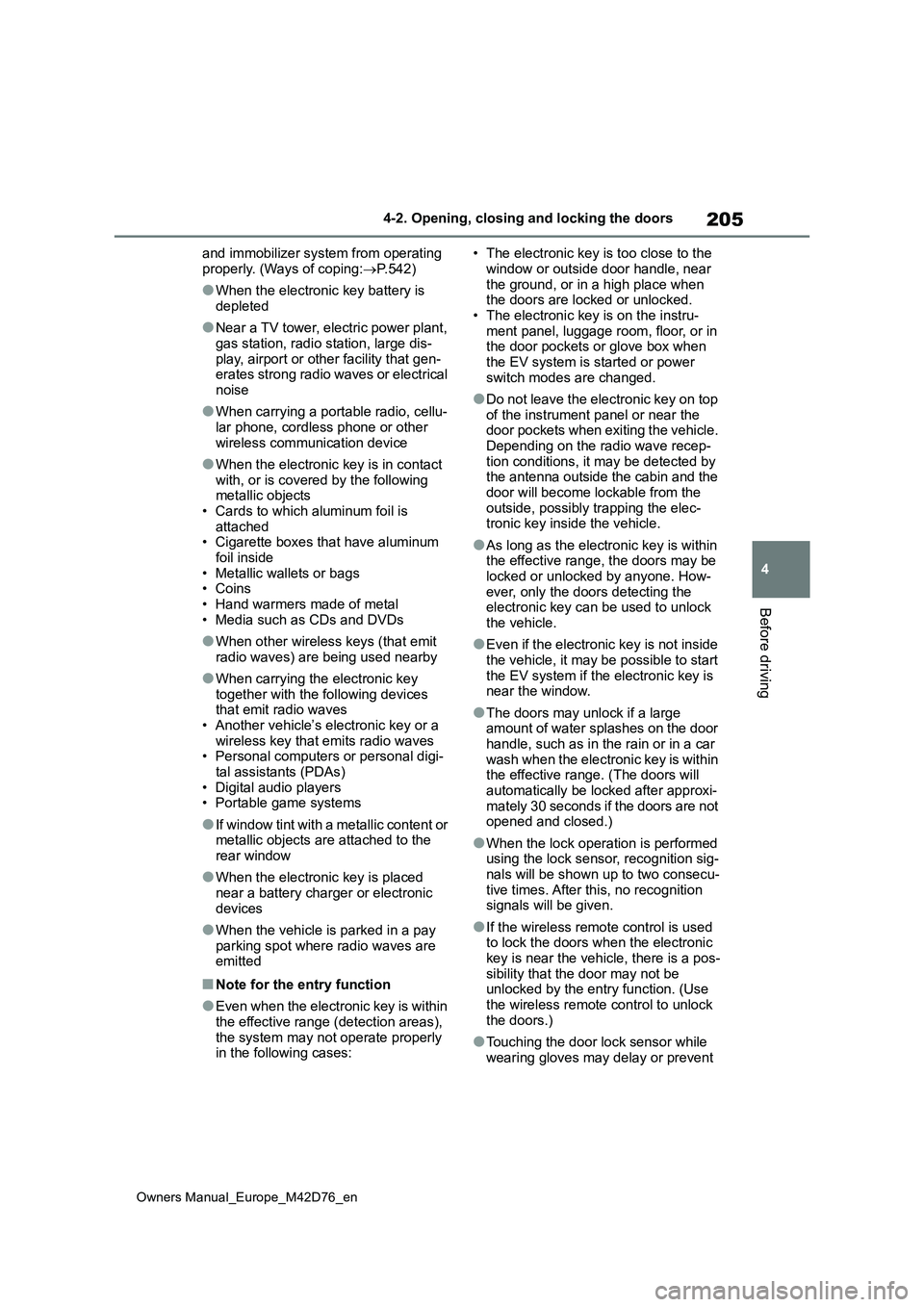
205
4
Owners Manual_Europe_M42D76_en
4-2. Opening, closing and locking the doors
Before driving
and immobilizer system from operating
properly. (Ways of coping: P.542)
●When the electronic key battery is
depleted
●Near a TV tower, electric power plant,
gas station, radio station, large dis- play, airport or other facility that gen-erates strong radio waves or electrical
noise
●When carrying a portable radio, cellu-
lar phone, cordless phone or other wireless communication device
●When the electronic key is in contact with, or is covered by the following metallic objects
• Cards to which aluminum foil is attached• Cigarette boxes that have aluminum
foil inside • Metallic wallets or bags• Coins
• Hand warmers made of metal • Media such as CDs and DVDs
●When other wireless keys (that emit radio waves) are being used nearby
●When carrying the electronic key together with the following devices that emit radio waves
• Another vehicle’s electronic key or a wireless key that emits radio waves• Personal computers or personal digi-
tal assistants (PDAs) • Digital audio players• Portable game systems
●If window tint with a metallic content or metallic objects are attached to the
rear window
●When the electronic key is placed
near a battery charger or electronic devices
●When the vehicle is parked in a pay parking spot where radio waves are emitted
■Note for the entry function
●Even when the electronic key is within the effective range (detection areas),
the system may not operate properly in the following cases:
• The electronic key is too close to the
window or outside door handle, near the ground, or in a high place when the doors are locked or unlocked.
• The electronic key is on the instru- ment panel, luggage room, floor, or in the door pockets or glove box when
the EV system is started or power switch modes are changed.
●Do not leave the electronic key on top of the instrument panel or near the door pockets when exiting the vehicle.
Depending on the radio wave recep- tion conditions, it may be detected by the antenna outside the cabin and the
door will become lockable from the outside, possibly trapping the elec-tronic key inside the vehicle.
●As long as the electronic key is within the effective range, the doors may be
locked or unlocked by anyone. How- ever, only the doors detecting the electronic key can be used to unlock
the vehicle.
●Even if the electronic key is not inside
the vehicle, it may be possible to start the EV system if the electronic key is near the window.
●The doors may unlock if a large amount of water splashes on the door
handle, such as in the rain or in a car wash when the electronic key is within the effective range. (The doors will
automatically be locked after approxi- mately 30 seconds if the doors are not opened and closed.)
●When the lock operation is performed using the lock sensor, recognition sig-
nals will be shown up to two consecu- tive times. After this, no recognition signals will be given.
●If the wireless remote control is used to lock the doors when the electronic
key is near the vehicle, there is a pos- sibility that the door may not be unlocked by the entry function. (Use
the wireless remote control to unlock the doors.)
●Touching the door lock sensor while wearing gloves may delay or prevent
Page 212 of 674
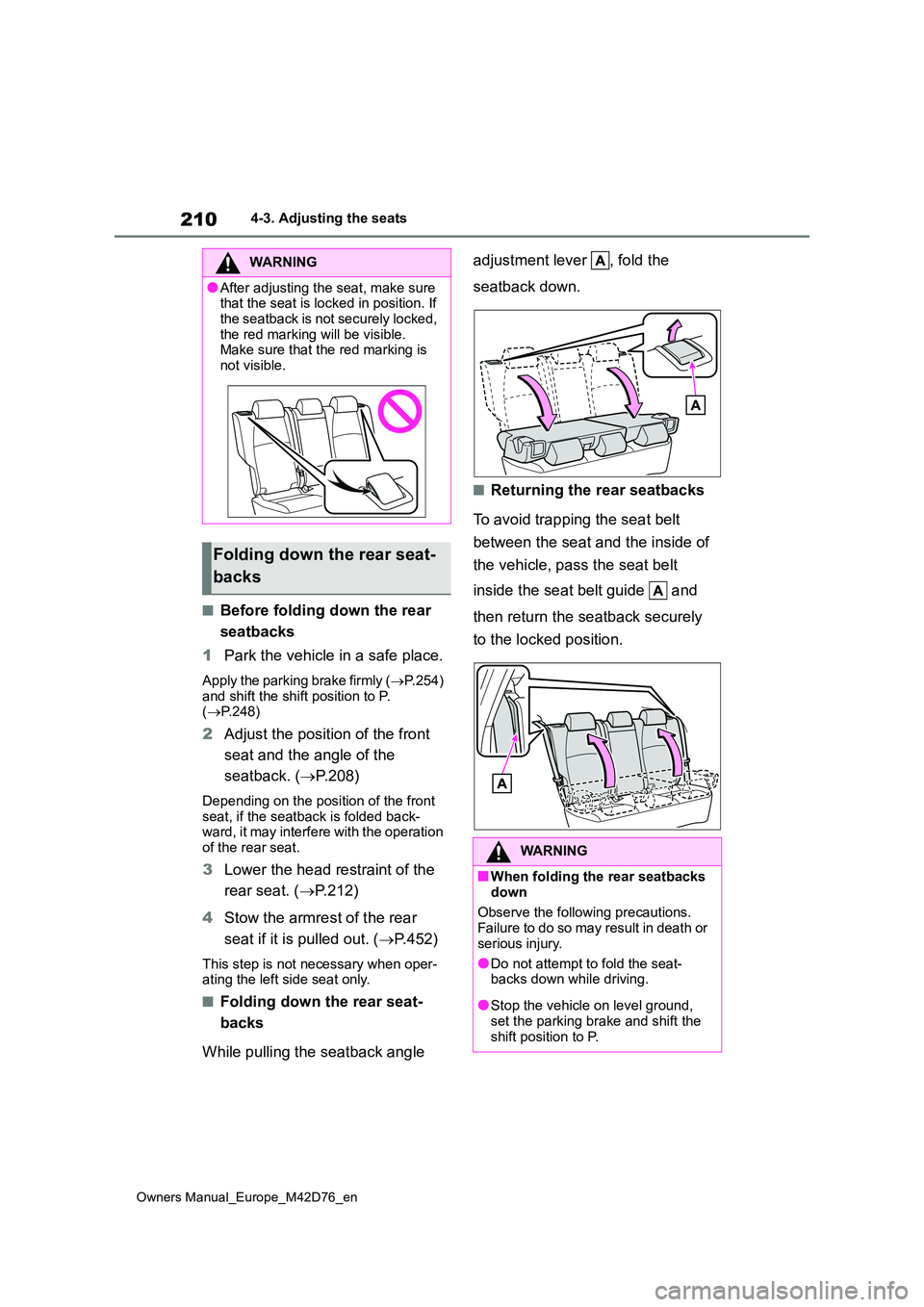
210
Owners Manual_Europe_M42D76_en
4-3. Adjusting the seats
■Before folding down the rear
seatbacks
1 Park the vehicle in a safe place.
Apply the parking brake firmly (P.254) and shift the shift position to P. ( P.248)
2Adjust the position of the front
seat and the angle of the
seatback. ( P.208)
Depending on the position of the front seat, if the seatback is folded back-ward, it may interfere with the operation
of the rear seat.
3 Lower the head restraint of the
rear seat. ( P.212)
4 Stow the armrest of the rear
seat if it is pulled out. ( P.452)
This step is not necessary when oper- ating the left side seat only.
■Folding down the rear seat-
backs
While pulling the seatback angle
adjustment lever , fold the
seatback down.
■Returning the rear seatbacks
To avoid trapping the seat belt
between the seat and the inside of
the vehicle, pass the seat belt
inside the seat belt guide and
then return the seatback securely
to the locked position.
WARNING
●After adjusting the seat, make sure that the seat is locked in position. If
the seatback is not securely locked, the red marking will be visible. Make sure that the red marking is
not visible.
Folding down the rear seat-
backs
WARNING
■When folding the rear seatbacks
down
Observe the following precautions. Failure to do so may result in death or
serious injury.
●Do not attempt to fold the seat- backs down while driving.
●Stop the vehicle on level ground, set the parking brake and shift the
shift position to P.
Page 214 of 674
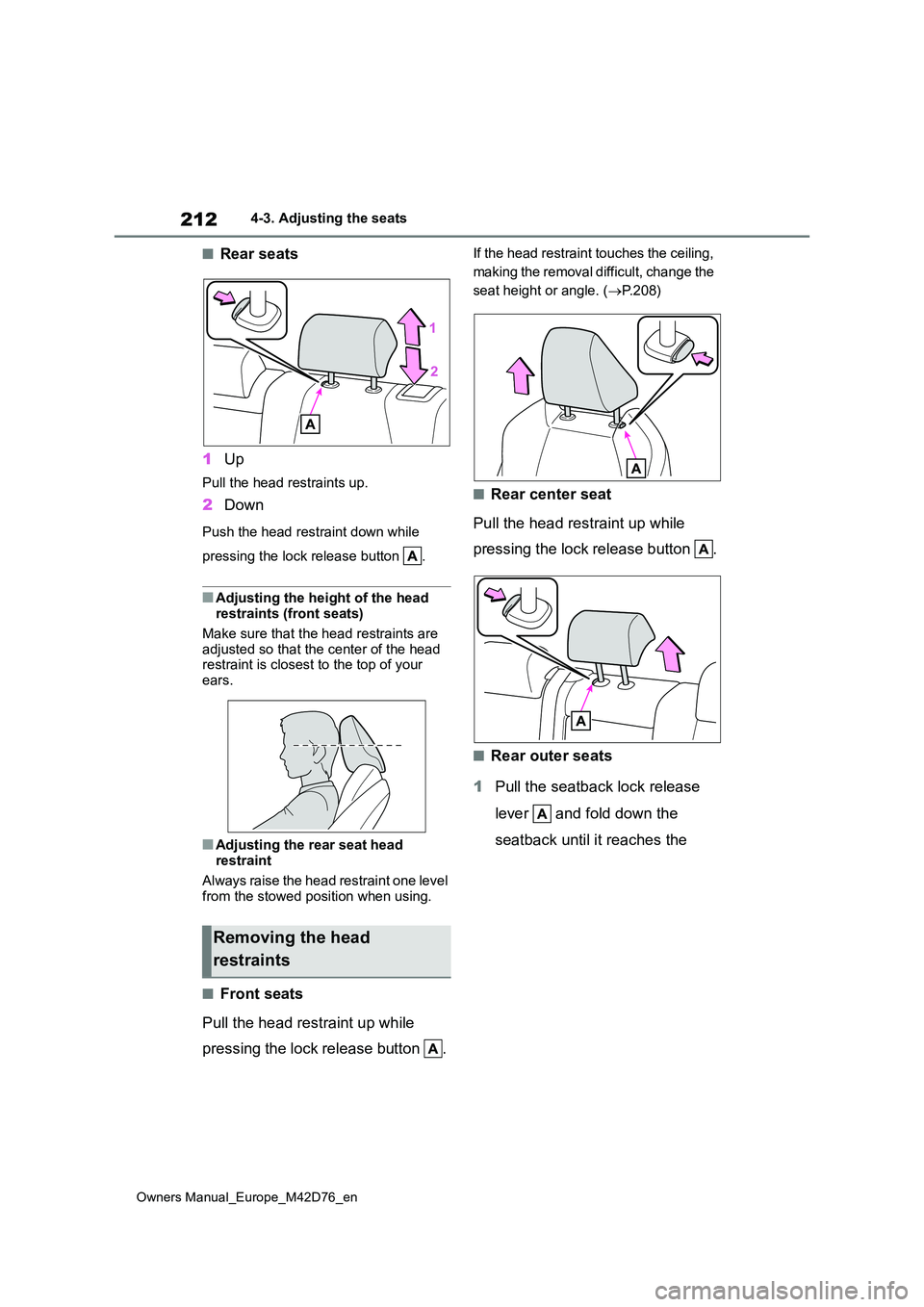
212
Owners Manual_Europe_M42D76_en
4-3. Adjusting the seats
■Rear seats
1 Up
Pull the head restraints up.
2Down
Push the head restraint down while
pressing the lock release button .
■Adjusting the height of the head restraints (front seats)
Make sure that the head restraints are adjusted so that the center of the head restraint is closest to the top of your
ears.
■Adjusting the rear seat head
restraint
Always raise the head restraint one level
from the stowed position when using.
■Front seats
Pull the head restraint up while
pressing the lock release button .
If the head restraint touches the ceiling,
making the removal difficult, change the
seat height or angle. ( P.208)
■Rear center seat
Pull the head restraint up while
pressing the lock release button .
■Rear outer seats
1 Pull the seatback lock release
lever and fold down the
seatback until it reaches the
Removing the head
restraints
Page 220 of 674
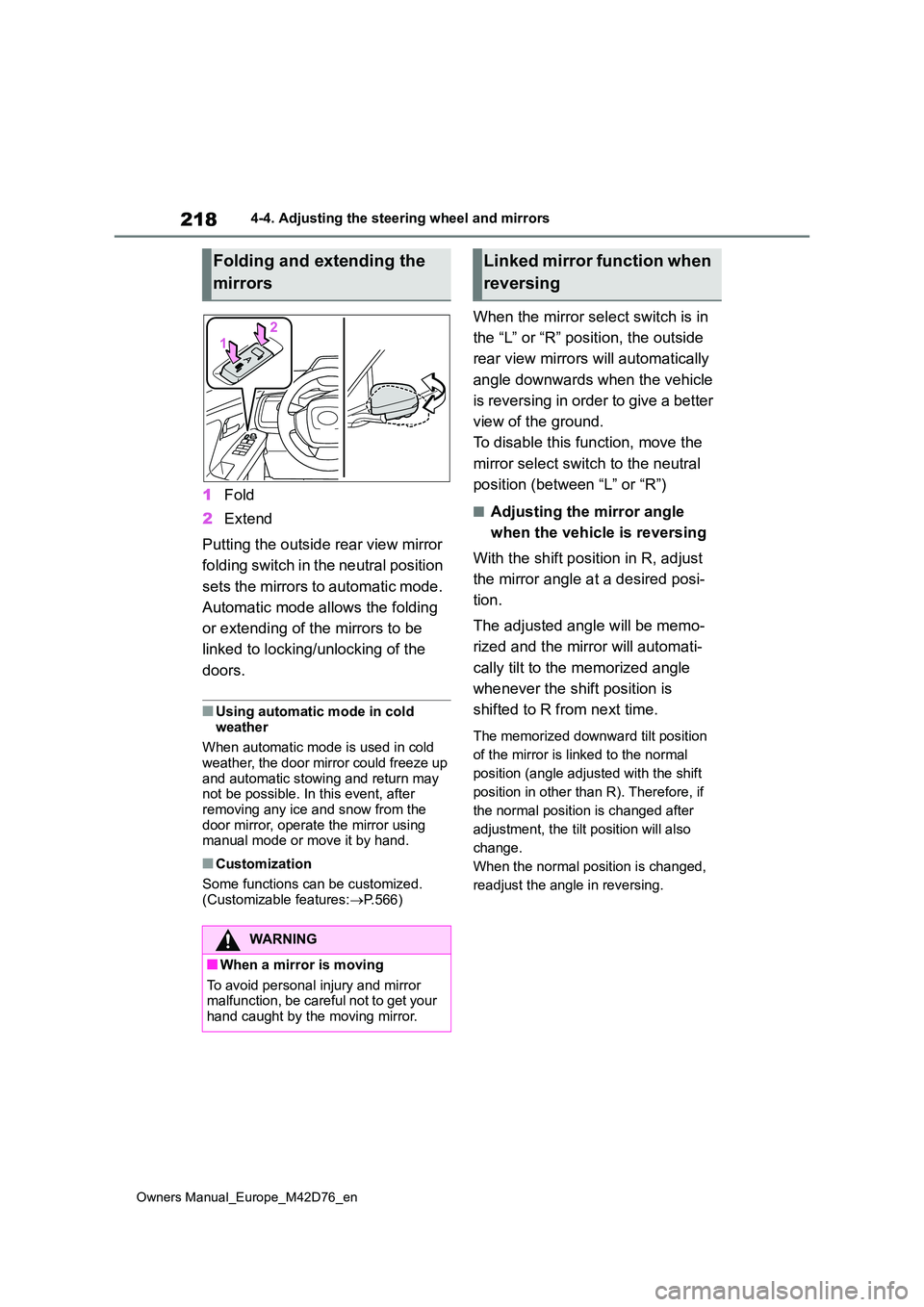
218
Owners Manual_Europe_M42D76_en
4-4. Adjusting the steering wheel and mirrors
1Fold
2 Extend
Putting the outside rear view mirror
folding switch in the neutral position
sets the mirrors to automatic mode.
Automatic mode allows the folding
or extending of the mirrors to be
linked to locking/unlocking of the
doors.
■Using automatic mode in cold
weather
When automatic mode is used in cold weather, the door mirror could freeze up
and automatic stowing and return may not be possible. In this event, after removing any ice and snow from the
door mirror, operate the mirror using manual mode or move it by hand.
■Customization
Some functions can be customized.
(Customizable features: P.566)
When the mirror select switch is in
the “L” or “R” position, the outside
rear view mirrors will automatically
angle downwards when the vehicle
is reversing in order to give a better
view of the ground.
To disable this function, move the
mirror select switch to the neutral
position (between “L” or “R”)
■Adjusting the mirror angle
when the vehicle is reversing
With the shift position in R, adjust
the mirror angle at a desired posi-
tion.
The adjusted angle will be memo-
rized and the mirror will automati-
cally tilt to the memorized angle
whenever the shift position is
shifted to R from next time.
The memorized downward tilt position
of the mirror is linked to the normal
position (angle adjusted with the shift
position in other than R). Therefore, if
the normal position is changed after
adjustment, the tilt position will also
change.
When the normal position is changed,
readjust the angle in reversing.
Folding and extending the
mirrors
WARNING
■When a mirror is moving
To avoid personal injury and mirror malfunction, be careful not to get your hand caught by the moving mirror.
Linked mirror function when
reversing
Page 229 of 674

5
227
Owners Manual_Europe_M42D76_en
5
Driving
Driving
5-1. Before driving
Driving the vehicle ............ 229
Cargo and luggage ........... 235
Trailer towing .................... 237
5-2. Driving procedures
Power (ignition) switch ...... 243
Transmission .................... 247
Turn signal lever ............... 253
Parking brake ................... 254
Brake Hold ........................ 257
5-3. Operating the lights and wip-
ers
Headlight switch ............... 259
AHS (Adaptive High-beam
System) .......................... 262
AHB (Automatic High Beam)
....................................... 265
Fog light switch ................. 268
Windshield wipers and washer
....................................... 269
5-4. Using the driving support
systems
Software update................ 273
Toyota Safety Sense ......... 275
Driver monitor ................... 282
PCS (Pre-Collision System)
........................................ 283
LTA (Lane Tracing Assist) . 294
LDA (Lane Departure Alert)
........................................ 299
RSA (Road Sign Assist) .... 304
Dynamic radar cruise control
........................................ 307
Cruise control.................... 316
Speed limiter ..................... 318
Emergency Driving Stop Sys-
tem.................................. 321
BSM (Blind Spot Monitor) . 324
SEA (Safe Exit Assist)....... 328
Toyota parking assist-sensor
........................................ 333
RCTA (Rear Crossing Traffic
Alert) ............................... 343
RCD (Rear Camera Detection)
........................................ 348
PKSB (Parking Support Brake)
........................................ 352
Static Objects Front and Rear
of the Vehicle .................. 357
Moving Vehicle Rear of the
Vehicle ............................ 359
Pedestrians Rear of the Vehi-
cle ................................... 361
Page 232 of 674

230
Owners Manual_Europe_M42D76_en
5-1. Before driving
●Drive carefully when it starts to rain,
because the road surface will be especially slippery.
●Refrain from high speeds when driv-ing on an expressway in the rain, because there may be a layer of water
between the tires and the road sur- face, preventing the steering and brakes from operating properly.
■Restraining the EV system output
(Brake Override System)
●When the accelerator and brake ped-
als are depressed at the same time, the EV system output may be restrained.
●A warning message is displayed on the multi-information display while the
system is operating.
■Breaking in your new Toyota
To extend the life of the vehicle, observ- ing the following precautions is recom-
mended:
●For the first 300 km (186 miles):
Avoid sudden stops.
●For the first 800 km (500 miles):
Do not tow a trailer.
●For the first 1000 km (621 miles):
• Do not drive at extremely high speeds.• Avoid sudden acceleration.
• Do not drive at a constant speed for extended periods.
WARNING
Observe the following precautions.
Failure to do so may result in death or serious injury.
■When starting the vehicle
Always keep your foot on the brake pedal while stopped with the
“READY” indicator is illuminated. This prevents the vehicle from creeping.
■When driving the vehicle
●Do not drive if you are unfamiliar with the location of the brake and
accelerator pedals to avoid depressing the wrong pedal.
• Accidentally depressing the accel- erator pedal instead of the brake pedal will result in sudden accelera-
tion that may lead to an accident.
• When backing up, you may twist
your body around, leading to diffi- culty in operating the pedals. Make sure to operate the pedals properly.
• Make sure to keep a correct driving posture even when moving the
vehicle only slightly. This allows you to depress the brake and accelera-tor pedals properly.
• Depress the brake pedal using your right foot. Depressing the brake
pedal using your left foot may delay response in an emergency, result-ing in an accident.
●The driver should pay extra atten-tion to pedestrians. As there is no
engine noise, the pedestrians may misjudge the vehicle’s movement. Even though the vehicle is
equipped with the Acoustic Vehicle Alerting System, drive with care as pedestrians in the vicinity may still
not notice the vehicle if the sur- rounding area is noisy.
●During normal driving, do not turn off the EV system. Turning the EV system off while driving will not
cause loss of steering or braking control, however, power assist to the steering will be lost. This will
make it more difficult to steer smoothly, so you should pull over and stop the vehicle as soon as it is
safe to do so. In the event of an emergency, such as if it becomes impossible to stop the vehicle in the
normal way: P. 5 0 6
Page 237 of 674
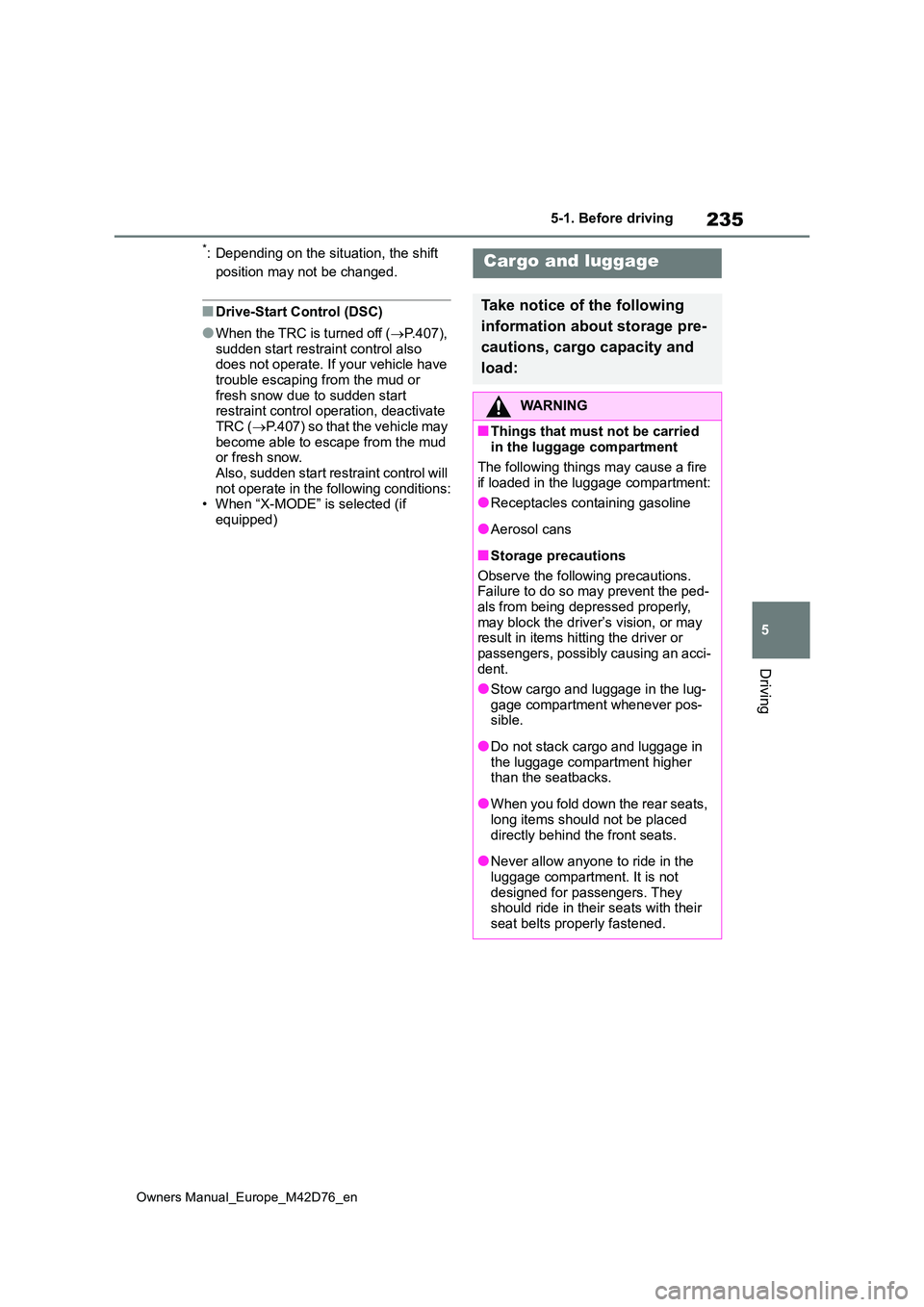
235
5
Owners Manual_Europe_M42D76_en
5-1. Before driving
Driving
*: Depending on the situation, the shift
position may not be changed.
■Drive-Start Control (DSC)
●When the TRC is turned off ( P.407),
sudden start restraint control also does not operate. If your vehicle have trouble escaping from the mud or
fresh snow due to sudden start restraint control operation, deactivate TRC ( P. 40 7 ) s o t h at t he ve hi c le ma y
become able to escape from the mud or fresh snow.Also, sudden start restraint control will
not operate in the following conditions: • When “X-MODE” is selected (if equipped)
Cargo and luggage
Take notice of the following
information about storage pre-
cautions, cargo capacity and
load:
WARNING
■Things that must not be carried in the luggage compartment
The following things may cause a fire if loaded in the luggage compartment:
●Receptacles containing gasoline
●Aerosol cans
■Storage precautions
Observe the following precautions. Failure to do so may prevent the ped-
als from being depressed properly, may block the driver’s vision, or may result in items hitting the driver or
passengers, possibly causing an acci- dent.
●Stow cargo and luggage in the lug-
gage compartment whenever pos- sible.
●Do not stack cargo and luggage in the luggage compartment higher than the seatbacks.
●When you fold down the rear seats, long items should not be placed
directly behind the front seats.
●Never allow anyone to ride in the
luggage compartment. It is not designed for passengers. They should ride in their seats with their
seat belts properly fastened.